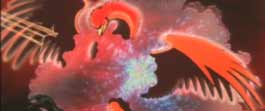|
Bells and Whistles As Tezuka began to work on the story, one of his first steps was to show the previous Phoenix film, Dawn, to people and ask for their opinions. Students, clerks, housewives - but they were far from ordinary members of the audience. In fact, they did not belong to his Japanese audience at all. They were American, and Tezuka met them during his visit to the US in 1979. It is well known that Tezuka was a fan of American cinema. Among the inspirations for 2772 he named Jaws, Star Wars, 2001: A Space Odyssey and Disney musicals. But inspiration for a creator is also a challenge, and 2772 was intended to rival the Western works, to prove that Japanese animation is capable of rising to their level and beyond. It shows even in the film's production method. The usual routine for a Japanese studio is to distribute all cuts among key animators, with animation director making sure that everybody maintains the same style. For 2772 Tezuka abandoned this method and switched to the so-called "character system", employed by Disney. Each of the main characters was drawn by a dedicated key animator, and if in some cut two such characters appeared together, both of their animators worked on that cut. I cannot judge how well the "character system" worked for 2772, nor indeed whether the old method would not have worked just as well. But it shows Tezuka's spirit of competition, his desire to surpass the Americans using their own methods of filmmaking. Of course, Tezuka wanted the animation to be smooth and fluent. In the sixties he created Japan's first animated television series and developed ingenious techniques of limited animation which are often used to this day. But he made a special point of using only full animation for 2772. I have repeatedly come across a statement that Tezuka misunderstood the meaning of "full animation" and insisted that everything on screen be completely redrawn for each frame. For moving shapes that is fine; but the lines that should be still, if redrawn, appear to wobble because human hand can never trace a line precisely. And indeed it is argued that all the outlines in 2772 are wobbly. This is a serious accusation - so serious that I am inclined to doubt it. Tezuka could be carried away by his enthusiasm, but he had enough experience in animation not to make stupid mistakes. The animation in 2772 is not faultless, but it is definitely not that bad. Characters' hands do not shake and furniture does not jitter. One exception is the robotic heroine, Olga. The highlights in her hair do visibly shift around in many scenes, but I think the effect is intentional. The hair seems to be alive - a clever way of hinting that the expressionless robot is more than just a machine. When Tezuka said he was inspired by Star Wars he meant mainly special effects, and he wanted 2772 to have equally stunning visuals. It was one of the very few Japanese animatied films (the only one I know, actually) to employ a rotoscope - a device that allows animators to trace over live-action reference. A two meter long model of the hero's spaceship was built, filmed and used for some truly breathtaking camerawork. Trick photography and computer graphics were used. It may not seem remarkable today, when even TV series have computer-generated special effects, but for 1980 it was very advanced technology. It is ironic that the film should now be remembered mainly for its technical flaws, the supposed wobbly outlines. But in a sense it was this very focus on form that did the film the greatest disservice. Anything new and advanced is bound sooner or later to go out of date, and then all the gloss of high technology is lost. Novelty for novelty's sake, form for form's sake does not endure. Substance does - but it is painfully clear even from the film's booklet that everybody starting with Tezuka himself thought more about creating a grand spectacle than a memorable story. Tezuka is known as the man who introduced new subject matter into Japanese comics - horror, suspense, melodrama, scientific and philosophical issues. But he also used to mix these elements freely with sight gags and preferred a rounded, cartoony drawing style even in serious stories. His approach to plot development was similarly lighthearted - the narrative flow in his comics is smooth, but the main plot device is often deus ex machina. Events can occur for no other reason than getting the maximum emotional response from the reader, like a sudden death of a likable character. And all the philosophy, drama and science are there chiefly to add to the entertainment. This worked extremely well on paper. As a comic 2772 would probably be a great unquestionable success. As it is, 2772 is a somewhat controversial work with its flaws and strong points, jarring scenes and memorable moments of pure beauty. But above all it represents Tezuka's approach to storytelling and animation, and as such deserves attention of all the fans of this great man. A.Panina |
